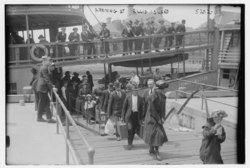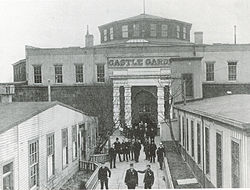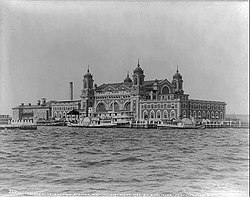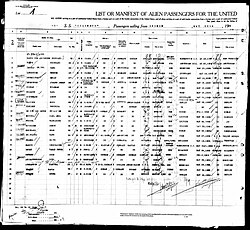See also: US passenger lists
Ship passenger lists, also known as manifests, can provide valuable genealogical information and can be an important tool for tracing your ancestors’ immigration journey.
Research your ancestors on MyHeritage
Immigration to AmericaImmigration to America

Immigrants came to America in various waves:
- The first explorers and settlers came to North America in the 1500s.
- In the 1600s, immigrants from England came to the area that became the 13 colonies.
- Immigration to the 13 colonies increased after 1700 with a wave of 450,000 immigrants.
- From 1825 – 1880 almost 7.5 million immigrants entered the United States during this second wave. The majority came from northern and western Europe.
- From 1881 to 1920, more than 23 million people arrived at immigration ports, such as Ellis Island in New York.
- According to the Population Reference Bureau, “the United States admitted an average 250,000 immigrants a year in the 1950s, 330,000 in the 1960s, 450,000 in the 1970s, 735,000 in the 1980s, and over 1 million a year since the 1990s.”
Major U.S. arrival ports for immigrationMajor U.S. arrival ports for immigration

The five major U.S. arrival ports for immigration in the 19th and 20th centuries were: New York, Boston, Baltimore, Philadelphia, and New Orleans.
New York was by far the most commonly used port, followed by the others. More than 70 percent of all immigrants entered through New York City. Throughout the late 1800s, most immigrants arriving in New York entered at the Castle Garden depot near the tip of Manhattan.
Castle Garden (now Castle Clinton), located in the Battery of Manhattan, was the nation's first immigrant processing facility and served as the New York State (city-run) immigration station from 1855 to 1890.

The Federal Government assumed control of immigration in 1890 by opening the first federal immigrant processing center at the Barge Office in Battery Park. This office served as the first federal immigrant processing center from April 19, 1890, to December 31,1891.
The first Ellis Island Immigration Station officially opened on January 1,1892 ,but was destroyed by fire on June 15, 1897. All Ellis Island records dating back to 1840 and the Castle Garden era were destroyed. The immigration process was returned to the Barge from June 15, 1897, through December 16, 1900. The new Ellis Island facility officially operated between December 17, 1900 and November 29, 1954.
Where to find passenger recordsWhere to find passenger records

Passenger lists can be found on many online genealogy and historical websites. MyHeritage provides a large selection of passenger lists under the Immigration and Travel research tab. These lists can be refined to limit topics by region or year.
Lists are also available on sites such as the National Archives and the Ellis Island Passenger Search database
The US census from 1900 forward asked responders for the year of a person’s immigration to the US. This can be a great help in locating and identifying immigrant ancestors.
Information provided in ship manifests and passenger listsInformation provided in ship manifests and passenger lists
Generally, the earlier our ancestors traveled, the less detailed information is available.
Early passenger lists typically include the name of the ship, the names of passengers, ages, ports of arrival and departure, date, country of origin, and occupation. Few passenger lists survive from before 1820. To find passenger information from before 1820, you will need to research indexes, newspapers and naturalization records.
Starting in 1820, the federal government required all US-bound ships to keep lists of their passengers. Over time these lists were standardized and by 1907 passenger manifests contained 29 columns and were two-pages wide with left and right sides.
Manifest header infoManifest header info
The manifest header contains the following information:
- Ship Name
- Departure Port
- Date Set Sail
- Arrival Port
- Date of Arrival
- Passenger Class
Immigrant’s personal InformationImmigrant’s personal Information
(The following columns from the manifest may provide valuable genealogical clues for your family research)
- NAME: The original passenger list was created in the port of departure and information was verified at the port of arrival so your ancestor’s name might be listed as it was in his/her native land. Names and spellings were not changed at arrival in the United States.
- AGE: Years and Months (but usually only years are completed) can provide valuable clues to birth dates or help identify ancestors on other documents.
- MARITAL STATUS: can provide information if spouse is already in the US or still overseas or if ancestor is single.
- LAST PERMANENT RESIDENCE: indicates if your ancestor may have lived other than the place of birth.
- NAME AND COMPLETE ADDRESS OF NEAREST RELATIVE OR FRIEND FROM COUNTRY FROM WHENCE ALIEN CAME: can provide information on additional ancestors
- FINAL DESTINATION (City/State): provides another lead for additional document searches (city directories, census, etc)
- WHETHER EVER BEFORE IN THE UNITED STATES (When/Where): additional research opportunities. Many immigrants worked in the US for a while, returned home and came back to the US with their families.
- WHETHER GOING TO JOIN A RELATIVE OR FRIEND (If so who/address): Provides more research data (city directories, census).
- PLACE OF BIRTH (City/Town): provides valuable information for when you are ready to take your research “across the pond”.
Some helpful tips for researching ship manifestsSome helpful tips for researching ship manifests
- Records did not survive for all ships and did not always include all passengers
- Immigration years listed on census records may not be accurate. Use a range when searching for ship manifests.
- Search ship manifests for other immigrants from the same town as your ancestor. They may have traveled together.
- Watch for name spelling variations
- Arrival records are restricted due to personally identifiable information for 75 years by the National Archives and must be requested through a Freedom of Information Act (FOIA) request during the restricted period.
Search immigration & travel records in the United StatesSearch immigration & travel records in the United States
Explore more about ship manifestsExplore more about ship manifests
Here are a few online resources that can be used to research passengers on pre-1820 ships traveling to America. Others are also available but may not be very detailed.
- U.S. passenger list collections on MyHeritage
- Pilgrim Ship Lists Early 1600s
- Passenger and Immigration Lists Index
- Immigrant Servants Database
- Immigrant Arrivals: A Guide To Published Sources
Other resources on this topic:
- Beyond the Arrival Date: Extracting More from Passenger Lists, webinar by Lisa A. Alzo, M.F.A. on Legacy Family Tree Webinars
- Find a Boatload of Passenger Lists on MyHeritage, webinar by Sharon Monson on the MyHeritage Knowledge Base
- Find your ancestors who immigrated and their relatives in the New York passenger announcements, webinar by Mike Mansfield on the MyHeritage Knowledge Base

